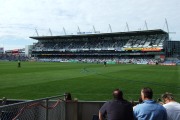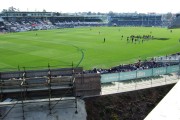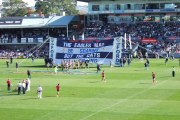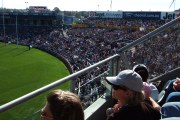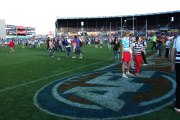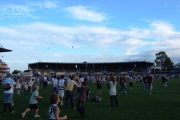Early winter in Geelong, with blue skies and temperatures in the low twenties (Centigrade) is not like going to Preston in November. I doubt many travelling fans watching England’s winter sport spend part of the morning eating breakfast at an outdoor café overlooking a palm-fringed beach. Given the size of the country, and the distance from Perth to Geelong (about as far as from Manchester to Athens) quite an impressive number made the trip, some of whom had also gone for the breakfast option after catching the early train from Melbourne.
This was to be my third AFL game, both in total and in as many days. The morning train journey had allowed me to buy a Sunday paper, read about yesterday’s Collingwood v Carlton clash, and see what today’s game had in prospect.
Today’s visitors, the West Coast Eagles, were the reigning champions, or “Premiers” as they are known in this part of the world. Geelong were an up and coming side, tipped by many for great things, but so far failing to deliver. They had a reputation as “flat track bullies”, mauling the weaker sides, but struggling against genuine contenders. To illustrate, the previous week they’d smacked 35 goals and 222 points, the 8th highest score ever in 100 years of AFL history, past the hapless Richmond, but they still went into the game with a won three, lost three, record. West Coast, by contrast, had won all six games so far.
One other intriguing thing, for me at least, was that Geelong were the last AFL club to still play at a traditional suburban ground. Just over half a mile south of Geelong station, next to typical low-rise neat wooden Australian houses, is Skilled Stadium or Kardinia Park as traditionalists would have it. Unlike the large modern stadiums, this ground held only 24,000 with an old wooden stand curving round one end, and even some terracing at the other.
The stand I’d be in was the modern and comparatively large Reg Hickey stand. Two tiers of seats, with executive boxes discreetly tucked in between, curved gracefully round side of the ground. The roof here was held up by cables hung from curving white supports, poking over the roofline like half a giant ribcage.
Opposite, perhaps highlighting the desire to modernise the ground, were four individual stands which just about linked together enough not look too untidy. Most out of place was the centre stand, whose high upturned modern roof was like a crooked tooth among the downward-sloping pitched roofs of its neighbours.
At the northern end of the stadium is the Gary Ablett Terrace. Nothing to do with Liverpool’s 1980s central defender, the Ablett in question here is a Geelong legend, being their record goal scorer and considered their best player of all time. For good measure his son, also named Gary Ablett, was in the current Geelong team, and was arguably the best current player in the game.
This end was mainly a single tier of seats curving round the goal, with a stand of executive boxes behind. About a third of this tier was given over to standing room, although the lack of crush barriers and presumably lower capacity leant it more an air of a grass bank at a cricket match than a football terrace.
At the opposite end is the two tiered wooden Doug Wade Stand, sweeping round the southern goal. Two tiers of seats, with the larger top tier being sheltered from the unpredictable Victoria weather by a roof whose many supporting pillars are painted blue, presumably to avoid clashing with the tall upright goal posts in front, as well as picking out the club colours.
And club colours were another reason I’d be nominally supporting Geelong today, as their blue as white hoops are reminiscent of my own Reading.
If Collingwood v Carlton the previous day had got me really into the sport, today’s game was the one that cemented it. In my innocence I kind of viewed Geelong as a plucky underdog up against the might of the current champions, and that was certainly how it panned out in the first two quarters. West Coast, to my untrained eyes anyway, looked the better side. Their passing and movement just looked crisper and more polished. They really looked dangerous every time they got the ball, and it was only sheer effort that prevented them scoring more often than they did. Geelong were less slick, but what they appeared to lack in class, they made up for in effort, as the gamely stayed in the game. So effective were they at doing this that they actually held a slender 9 point lead at half time.
At half time I sought refreshment and a chance to stretch my legs. Half time is full half hour, so there’s plenty of time , unlike the scramble at English grounds. I was also glad to get out of my seat for a bit. It was a lovely pleasant day in Geelong, pleasantly warm, but the top tier of the Reg Hickey Stand felt about 15 C hotter, as I baked in the sun. I thought it was just me being a bit English, but the locals were all talking about how hot they were too.
One of the joys about watching a sport you are unfamiliar with is how players who were complete unknowns to you a couple of hours before, flesh out and become real before your eyes. The names of Cameron Mooney, Gary and Nathan Ablett (yes, another son plays for them too), Cameron Ling, Jimmy Bartel and Matty Stokes for example, will mean nothing to most reading this. They meant nothing to me either at kick off, but they were soon my sporting heroes of the day, and I willed them on almost like a local.
If Geelong were gutsy in the first half of the game, they were brilliant in the second. They not only worked hardest now, they had the skill to match, and kicked five unanswered goals in the 3rd quarter. At 33 points, it ought to have been a winning margin, but the previous year, in the same fixture, Geelong had blown a 54 point lead to lose to West Coast – the 8th biggest capitulation in league history. When West Coast came out and quickly reduced the margin to 19 points, it wasn’t looking so convincing. But Geelong responded by upping a gear yet again to blow West Coast away with a flourish, as well as a 39 point winning margin. It was, according to the morning papers, a pivotal moment, and enough to have reporters wonder if a changing of the guard was taking place. 17 wins from their next 18 games, including the biggest winning Grand Final margin ever, was a rather emphatic yes.
Post game, completely unlike games in England (and not allowed at either of Melbourne’s stadiums either) the fans were invited to walk onto the field for a “kick to kick” session, where fans kick footballs to each other, while others just wander on to look around. I couldn’t ever imagine Man Utd ever inviting fans to walk onto the pitch at Old Trafford, let alone asking them to bring balls along for a kickabout, but that’s exactly what happened here. I went on, ducking the flying footballs, raining in from all angles like WWI Battle of the Somme artillery barrage, to take in the surrounds from the middle. The view from the middle of the pitch is always surprising. The stands never look quite how you expect them too. Taller, normally, and you get the smell of the grass. I’ve no idea why that should be a surprise but you never smell the grass from the seats. And I bet there’s not anyone, whatever their age, wouldn’t get a thrill out of kicking a goal where their heroes did just a few minutes earlier.
I couldn’t linger too long though. The one train an hour departing back to Melbourne left shortly, rammed full of supporters. As the low winter sun began to set, it felt like a perfect afternoon. And you could tell from the faces of the Geelong fans, who’d end a 44 year wait for a premiership that year, it had been a pretty special afternoon too.



